Trimming
Changing the length of clips or gaps on the timeline is called ‘trimming’.
Multitrack trimming is a valuable editing skill. By trimming multiple tracks at once, you can assure that the clips coming later on the timeline maintain their relative synchronization.
Trimming clips without consideration for content later on the timeline can disrupt the synchronization of your project. Soundtracks that don’t match the action and badly-timed titles are the kinds of problem that may result.

Multiple track trimming
Pinnacle Studio has powerful trimming tools to allow you to perform multitrack trimming without risk. Fortunately, there is a simple rule for safeguarding synchronization even on a complex timeline: open exactly one trim point on every track. Whether the trim point is attached to a clip or a gap, and at which end, are up to you.
To open a trim point on the active timeline track, position the timeline scrubber near the cut you want to trim, then click the trim mode button  on the timeline toolbar. To open one trim point on each non-empty track simultaneously, Shift-click the trim mode button.
on the timeline toolbar. To open one trim point on each non-empty track simultaneously, Shift-click the trim mode button.
 on the timeline toolbar. To open one trim point on each non-empty track simultaneously, Shift-click the trim mode button.
on the timeline toolbar. To open one trim point on each non-empty track simultaneously, Shift-click the trim mode button.Once in trim mode, you can open trim points with the mouse pointer at the beginning or end of a clip. Notice that the trim pointer faces left at the start of the clip and right at the end. While the trim pointer is showing, click once at the point you want to trim. Then continue to open trim points on other tracks if required.
You can open two trim points per track by holding down the Ctrl key to create the second point. This feature is useful for the trim both, slip trim, and slide trim operations, all described below.
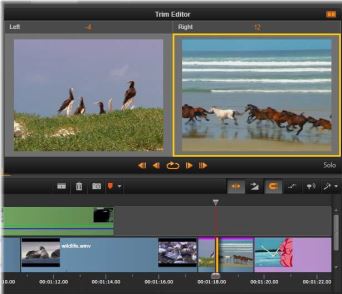
The Trim Editor in dual mode. The yellow rectangle shows the currently selected trim point at the start of a clip; the left side shows the final frame of the outgoing clip.
When a trim point is opened several things happen:
• The left or right edge of the clip is highlighted with a yellow bar, showing that it is currently selected. Trim points that are not currently selected are shown with an orange bar.
• The Trim Editor opens, with the Player in dual preview mode.
• The transport controls under the Player become trim adjustment tools.
• The preview with the currently active trim point is outlined in yellow.
In dual preview mode, the Trim Editor shows two frames from the timeline. The currently selected trim point is always shown and has a yellow rectangle around it. If the trim point is at the beginning of the clip, the first frame of the clip is shown; at the end of the clip, the last frame. You can switch the selected trim point by clicking in the other preview window, or by pressing Tab.

The Trim Editor in a slip trim operation. The left preview shows the currently selected trim point; the right preview shows the second trim point.
Which frame is shown in the second preview window depends on which trim mode is being used. In a slip or slide trim, the second trim point of the operation is displayed, surrounded by an orange rectangle. In other cases, the second preview window shows the frame on the other side of the cut at the selected trim point.
Above each preview window, the number of frames that have been trimmed is displayed. If you think of the original cut point position as zero, the number indicates how many frames the new position of the cut point has moved.
The Trim Editor is by default in solo mode. The clip that has the trim point is shown without the tracks above it and without any transitions applied to it. This preview mode is most suitable for determining the exact frame to trim. The default display of adjacent frames are a complete composition of all the timeline tracks. You can toggle the display behavior with the Solo button  in the lower right corner of the Trim Editor. When solo mode is deactivated, the preview shows trim points in their timeline context.
in the lower right corner of the Trim Editor. When solo mode is deactivated, the preview shows trim points in their timeline context.
 in the lower right corner of the Trim Editor. When solo mode is deactivated, the preview shows trim points in their timeline context.
in the lower right corner of the Trim Editor. When solo mode is deactivated, the preview shows trim points in their timeline context.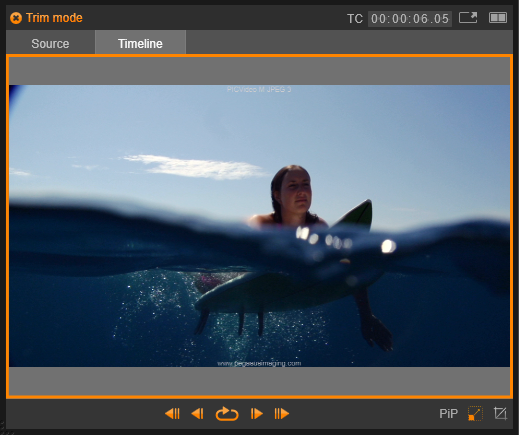
The Trim Editor in single preview mode.
The Trim Editor opens in dual preview mode. To switch to single preview, click the preview mode button  in the upper right corner of the preview area.
in the upper right corner of the preview area.
 in the upper right corner of the preview area.
in the upper right corner of the preview area.Closing trim mode: Trim mode can be closed by clicking the trim mode button  .
.
 .
.The current editing mode – smart, overwrite, insert, or replace – determines how trimming will affect other clips on the timeline. Select the mode from the dropdown list at the far right of the timeline toolbar.

Insert mode: Clips to the right of a trimmed clip and on the same track will shift left or right to accommodate the new length of the clip. Synchronization with other tracks may be lost, but no clips are overwritten.
Overwrite mode: Only the clips you are trimming, and any neighboring clips they happen to overwrite, are altered in this mode. Synchronization across tracks is not affected.
Smart mode: For trimming, smart mode is equivalent to insert mode.
Replace mode: Dragging a new clip over an existing clip in the timeline will replace the existing clip.
Prepare to trim the beginning of a clip (the ‘mark-in’ point) by clicking at the left-hand edge of the clip while the trim pointer is visible. With a trim point thus established, you can add or remove frames from the beginning of the clip.
To trim on the clip, drag the trim point to the left or right.
To trim on the Player, use the trim buttons to trim one or ten frames either forwards or backwards. Click the loop play button for a looping preview of the trim region.

The position of the playhead relative to the trim point helps distinguish the in-point of a clip (left) from the out-point of the previous clip (right).
To trim the end of the clip (or ‘mark-out’ point), open a trim point by clicking at the right-hand edge of a clip when the mouse pointer changes to a rightward-pointing arrow. Now you can add or remove frames from the end of your clip.
Once again you can trim directly on the clip by dragging the trim point, or on the Player while it remains in trim mode.
The project’s timeline lets you trim not just the clips upon it but also the gaps between them. Trimming gaps might not sound terribly useful at first, but is in fact handy. For instance, the easiest way to insert or delete space on a single timeline track is to trim the right- hand edge of a gap. All clips to the right of the gap are shifted as a block when this is done.
Also, when you need to open a trim point on each track in order to maintain synchronization while trimming, you may often choose to trim the duration of a gap rather than that of a clip. (Remember the rule: one trim point on every track is required for keeping in sync.)
Trimming a gap, whether at the start or the end, is accomplished in exactly the same way described above for trimming a clip.
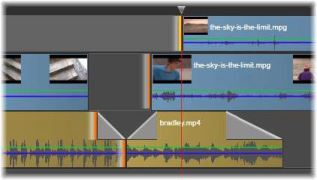
Two gaps and an audio out point have been selected for trimming. Because one trip point has been created on each track, the entire production stays in sync when trimmed.
In this operation, two adjacent clips (or a clip and an adjacent gap) are trimmed simultaneously. Any frames added to the left-hand item are taken away from the one on the right, and vice versa, as long as space and material are available. All you are moving is the cut-point where the items meet. One application for this technique is adjusting visual cuts to the beat of a music soundtrack.
To start, click at the end of the left-hand clip to open the first trim point, then Ctrl-click at the beginning of the right-hand clip to open the second.
When positioned over the adjacent trim points you just opened, the mouse pointer should be a horizontal two-headed arrow. Drag left or right to move the clip boundary, or use the Player in trim mode.
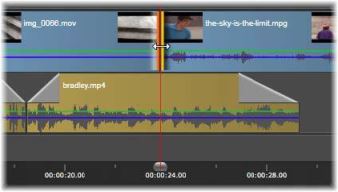
Trim both: Adjacent out and in trim points have been selected. Dragging the trim points affects the timing of the hand-off from the outgoing clip to the incoming one, but does not disrupt the timeline.
Over-trimming occurs when you try to extend the duration of a clip beyond the limits of its source material, a situation you typically want to avoid.
Notice that if you have over-trimmed your clip the invalid parts are shown in pink.

Overtrimmed clip: The first and last frames will be frozen in the over-trimmed sections.
Over-trimming is not a crisis situation. You do not need to take action immediately. Pinnacle Studio will simply extend the clip as specified by ‘freezing’ the first and last frames of the clip into the over-trimmed areas.
Depending on the duration of the over-trim, and the context, this simple approach may be all you need. A brief freeze-frame can even be visually effective in its own right.
The freeze-frame method will probably not give satisfactory results if it happens during a sequence involving rapid motion, however. In such exacting cases you might consider supplementing or replacing the clip, or prolonging it by changing the speed. (See Controlling speed with Time Remapping.)
To change the starting frame of a clip within the source material, but leave its duration unchanged, open one trim point at the start of a clip, and another at the end of either the same clip or one later on its timeline track.
Drag either trim point horizontally or use the Player trim controls to reposition the clip within its source.

Slip trim: With the in and out trim-points of a clip selected, dragging the clip changes its in and out points relative to the original material, but doesn’t affect its start time or duration on the timeline.
A slide trim is an extended version of the trim both technique described above. In this case you open trim-points at the end of one clip and the beginning of another later on the timeline. Instead of sliding a single clip boundary along the timeline, as in trim both, you are sliding two that move together. All clips between the two trim points are repositioned earlier or later on the timeline.
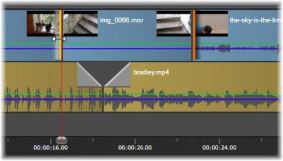
Slide trim: An out-point has been opened for trimming on the first clip, and an in-point on the third. Dragging either point moves the center clip – or multiple clips, if more are present – along the track while other clips remain stationary.
Both slip trimming and slide trimming can be useful for synchronizing clip contents to material on other tracks.
When you are trimming with multiple trim points, it is helpful to switch the preview from one trim location to another to make sure that each is properly set. Selecting a trim point for monitoring makes it the source for audio and video during preview.
Monitoring is enabled for a trim point when it is created. When multiple trim points are created in succession, you can fine tune each one as you go. To select an existing trim point for monitoring, Ctrl- click it. While trim mode is active, use Tab or Shift+Tab to cycle through the open points.
After using Ctrl-click to monitor a trim point, trimming can be controlled with the Left and Right arrow keys. Trim one frame using the keys unshifted; add the Shift key to trim in 10-frame steps.
To move a selection of one or more clips, place the mouse pointer on any selected clip and watch for it to change to a hand symbol. When it does, start dragging the clip to the desired position.
Move can be thought of as a two-step process. First, the selection is deleted from the current timeline, according to the rules of the current edit mode. Second, the selection is moved to the desired end position, where it is inserted in a left-to-right fashion per track. The relative position of all selected clips on all tracks is retained.
Moving a ‘sparse selection’ (a selection in which some clips per track are selected while others in the same region are not) is possible, but may be confusing unless executed in overwrite mode. Moving either single clips or a complete timeline cross-section is more straightforward and should be preferred when possible.
Holding down the Alt key while moving clips allows you to toggle between insert and overwrite modes. Standard smart operation is the same as insert, since the most frequent use of horizontal moves is to reorder the playback sequence.
Copying clips: Holding down the Ctrl key while moving a selection of clips will copy the clips instead of moving them.